| |
Erroneous
Mode of Baptism |
|
The
last instructions that the resurrected Christ gave to His disciples
before ascending to Heaven is called the GREAT COMMISSION:
Go
ye therefore, and make disciples of all the nations, baptizing
them into the name of the Father, and of the Son, and of the Holy
Ghost: Teaching them to observe all things whatsoever I have commanded
you: and behold, I am with you always, even unto the end of the
world. Amen. (Matthew 28:19-20).
For the first
3 centuries, the Christians took this command literally and baptized
ADULTS by TRIUNE immersion into the name of the Father, Son, and
Holy Spirit.
Here is a quote
from Saint Basil the Great (330-379)—one of the most important
saints of the Orthodox Church:
This great
sign of baptism is fulfilled in three immersions,
with three invocations, so that the
image of death might be completely formed, and the newly-baptized
might have their souls enlightened with divine knowledge. (St.
Basil the Great, On the Holy Spirit, p. 59).
Here
is a quote from the Apostolical Constitutions written sometime
around A.D. 200:
50. If any bishop or presbyter does not perform
the three immersions of the one admission,
but one immersion, which is given into the death of Christ, let
him be deprived; for the Lord did not say, "Baptize into
my death," but, "Go ye and make disciples of all nations,
baptizing them into the name of the Father, and of the Son, and
of the Holy Spirit." Do ye, therefore, O bishops, baptize
thrice into one Father, and Son, and Holy Spirit, according
to the will of Christ, and our constitution by the Spirit? (Apostolical
Constitutions, Ante-Nicene Christian Library, vol. 17, p.
263).
Due
to the almost total destruction of Christian history at the time
of Emperor Diocletian, we can only quote a few sources, but the
Orthodox Church retains the original formula, and the Latins baptized
3 times by immersion until the 13th century.
The
Latin baptismal formula was changed in the 13th century
According
to the teaching of the Latin Church, baptism is absolutely necessary
for salvation and is the only gateway to the kingdom of Heaven:
Holy
Baptism is the basis of the whole Christian life, the gateway
to life in the Spirit (vitae spiritualis ianua), and the door
which gives access to the other sacraments. Through Baptism we
are freed from sin and reborn as sons of God; we become members
of Christ, are incorporated into the Church and made sharers in
her mission: "Baptism is the sacrament of regeneration through
water in the word."
(Catechism
of the Catholic Church, 1997, Part Two, Article 1).
Baptism is administered
by AFFUSION or pouring water on the head and invoking the
name of the Father, Son, and Holy Spirit. This innovation only goes
back to the time of the Reformation and was started by the Jesuits.
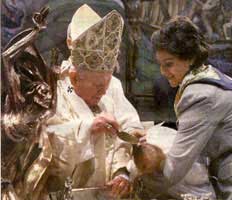
Pope
John Paul II baptizing an infant.
|
Latin
baptism is done by AFFUSION or pouring water on the head
and invoking the name of the Trinity.
The
baby is held upside down and in the WRONG position for "baptism."
|
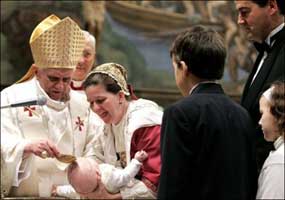 Pope
Benedict XVI baptizing an infant. Pope
Benedict XVI baptizing an infant.
|
Apostolic baptism
was done by the candidate for baptism plunging his/her head under
the water 3 times. No assistance was necessary from another person
(unlike backwards baptism) except to say the baptismal formula.
Of course, infants could not do this simple exercise of bowing 3
times into the water and so were NOT candidates for baptism.
Before the Reformation,
infants were baptized once or three times by immersion with their
faces toward the water.
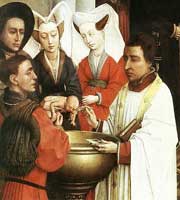
13th
century depiction of infant baptism.
|
Before
the Reformation, the baby went face down once
or three times into the water.
It was
under orders from the Jesuit generals that AFFUSION or pouring
was substituted for immersion.
|
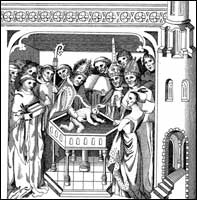
14th
century Saxon baptism.
|
Here is a quote
from a monumental History of Baptism written in the year
1817:
Immersion,
singe or trine was the ordinary mode of baptism in the Catholick
church from the beginning till the reformation, and the Lutheran
reformers continued it. In regards to the Catholicks, the evidence
is beyond all contradiction. Canons, manuals, legends, histories
and homilies describe it in words: and monuments, baptisteries,
and pictures in missals describe it in sculpture and painting.
(Robinson,
History of Baptism, p. 393).
Most movies
or pictures of the baptism of Joshua show him going backwards
into the water. This is a complete error because John the Baptist
was able to baptize thousands of people every day and this would
have been impossible if he had to dip them backwards into the water.

Joshua
went down into the water face first.
|
The
1977 Franco Zeffirelli movie Jesus
of Nazareth correctly depicts the baptism of Joshua.
Roman
centurion Cornelius—the first non-Jew to became a
Christian—was baptized by St. Peter head first and
with 3 immersions in the Name of the Father, Son and Holy
Spirit.
|

Baptism
of Cornelius by St. Peter.
|
Joshua came
up immediately out of the water, without any assistance, which would
have been impossible if he went down backwards into the water.
And straightway
coming up out of the water, he saw the heavens opened, and the
Spirit like a dove descending upon him. (Mark 1:10).
Here is a quote
from Saint John Chrysostom (347-407)—one of the 3 most important
saints in the Orthodox Church:
For when we
immerse our heads in water, the old is buried as in a tomb below,
and wholly sunk for ever: then as we raise them again, the new
man rises in its stead. As it is easy to dip and lift our heads
again, so it is easy for God to bury the old man, and to show
forth the new. And this is done thrice,
that you may learn that the power of the Father, the Son, and
the Holy Ghost fulfilleth all things. (St. John
Chrysostom, Homilies
on St. John, p. 211).
To this very
day, the Orthodox still retain the Apostolic pattern, and anybody
joining the Orthodox Church from the Latin (or most Protestant churches),
must be rebaptized the Scriptural way by triune immersion.
Up to the 13th
century, single immersion was limited to Spain, but was popularized
by the teachings of a Dominican monk named Thomas Aquinas.

Thomas
Aquinas (1215-1274).
|
Thomas
Aquinas was the authoritative teacher of the Latin Church,
second only to Augustine of Hippo in influence.
He
is called the Angelic Doctor or Doctor Angelicus.
He
admitted that triune immersion was the proper mode of baptism,
but single immersion was still valid . . . even though it
was a grievous sin!! |
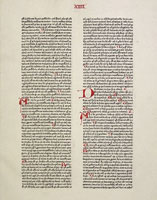
A
page of the Summa Theologica.
|
This
doctor of the Latin Church quotes Augustine in a debate about the
mode of baptism, and admits that triune immersion was the common
practice:
Objection
1. It seems that trine immersion is essential to Baptism. For
Augustine says in a sermon on the Symbol, addressed to the Neophytes:
"Rightly were you dipped three times, since you were baptized
in the name of the Trinity. Rightly were you dipped three times,
because you were baptized in the name of Jesus Christ, Who on
the third day rose again from the dead. For that thrice repeated
immersion reproduces the burial of the Lord by which you were
buried with Christ in Baptism." Now both seem to be essential
to Baptism, namely, that in Baptism the Trinity of Persons should
be signified, and that we should be conformed to Christ's burial.
Therefore it seems that trine immersion is essential to Baptism.
("Catholic"
Encyclopedia, article on baptism).
Then he quotes
Pope Gregory to show that the rite was changed to single immersion
by the Spanish Fourth Council of Toledo in 633:
On the contrary,
Gregory wrote to the Bishop Leander: "It cannot be in any
way reprehensible to baptize an infant with either a trine or
a single immersion: since the Trinity can be represented in the
three immersions, and the unity of the Godhead in one immersion."
I answer that
As stated above (7, ad 1), washing with water is of itself required
for Baptism, being essential to the sacrament: whereas the mode
of washing is accidental to the sacrament. Consequently, as Gregory
in the words above quoted explains, both single and trine immersion
are lawful considered in themselves; since one immersion signifies
the oneness of Christ's death and of the Godhead; while trine
immersion signifies the three days of Christ's burial, and also
the Trinity of Persons.
But for various
reasons, according as the Church has ordained, one mode has been
in practice, at one time, the other at another time. For since
from the very earliest days of the Church some have had false
notions concerning the Trinity, holding that Christ is a mere
man, and that He is not called the "Son of God" or "God"
except by reason of His merit, which was chiefly in His death;
for this reason they did not baptize in the name of the Trinity,
but in memory of Christ's death, and with one immersion. And this
was condemned in the early Church. Wherefore in the Apostolic
Canons (xlix) we read: "If any priest or bishop confer baptism
not with the trine immersion in the one administration, but with
one immersion, which baptism is said to be conferred by some in
the death of the Lord, let him be deposed": for our Lord
did not say, "Baptize ye in My death," but "In
the name of the Father and of the Son, and of the Holy Ghost."
Later on,
however, there arose the error of certain schismatics and heretics
who rebaptized: as Augustine (Super. Joan., cf. De Haeres. lxix)
relates of the Donatists. Wherefore, in detestation of their error,
only one immersion was ordered to be made, by the (fourth) council
of Toledo, in the acts of which we read: "In order to avoid
the scandal of schism or the practice of heretical teaching let
us hold to the single baptismal immersion."
But
now that this motive has ceased, trine immersion is universally
observed in Baptism: and consequently anyone baptizing otherwise
would sin gravely, through not following the ritual of the Church.
It would, however, be valid Baptism.
("Catholic"
Encyclopedia, article on baptism).
In
the West and East, triune immersion in the Name of the Father, Son,
and Holy Spirit was the common practice until the 13th century.
The
Fourth Council of Toledo changed the mode of baptism
The
Fourth Council of Toledo was held in Toledo, Spain, in the year
633. It was not an ecumenical council and no Greeks were present.
The Pope at that time was Gregory I, also called Gregory the GREAT.
At
that time, the Vatican called anyone who did not belong to their
church by the contemptuous title, ARIAN....An ARIAN meant anybody
who didn't believe in the Trinity. The Goths of Spain would not
unite with the Papacy and they considered themselves to be the true
Catholics:
The
Arians of Spain commonly referred to Catholicism as "the
Roman religion", while Arianism was considered by them to
be "the Catholic faith."' To become a Nicaean was, so
to speak, to become a Roman, to cease to be a Goth. But they cannot
seriously have regarded Arianism as 'catholic': that would have
been in contradiction with the use of Gothic as the liturgical
language and with the requirement of rebaptism of converts from
Catholicism. (Thompson, The Goths in Spain, p. 40).
Now
these "ARIAN" Goths in Spain baptized by TRIPLE IMMERSION
even though the Roman historians say they didn't believe in the
Trinity:
The triple as well as the simple immersion at baptism
was recognized by the Catholic Church until
it was noticed that the Arians of Spain immersed thrice.
In a letter to Leander of Seville, Gregory the Great then recommended
the Catholics to immerse once only so as to distinguish themselves
from the heretics? (His letter was written in April 591 when Arianism
had been smashed, and the need to distinguish Catholic baptismal
rites from Arian ones might seem to have been less pressing than
it had formerly been.) The problem was a puzzling one: it had
already been raised among the Catholics of the Suevic kingdom
of Galicia. It had been discussed by Pope Vigilius in 538 in a
letter to Profuturus, Metropolitan of Braga,who had asked Rome
for a ruling on this and other matters; and Vigilius, unlike his
great successor, had declared in favour of the triple immersion.
(Thompson,
The Goths in Spain, p. 41-42)).
Arian, Donatist
or Nestorian were derisive names given by the Vatican to anyone
who did not follow her false doctrines.
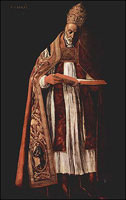
Pope
Gregory I (540-604).
Reigned from 590 to 604.
|
The
Gothic Christians of Spain were contemptuously called
"ARIANS" even though they practiced TRIUNE immersion.
In order
not to copy the "heretics," Pope Gregory authorized
Leander, bishop of Seville, to change the baptismal mode
to single immersion.
|
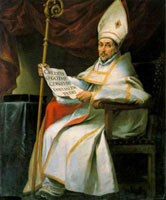
Bishop
Leander of Seville (534-600).
Bishop of Seville from 579 to 600.
|
This was the
first mention of single immersion . . . and it was limited to Spain.
n
order not to copy the "ARIAN" Goths who baptized by TRIPLE
IMMERSION, the Pope changed the mode to single immersion....Confused??....
Babylon means CONFUSION.
Pope
Gregory was called GREAT because he sent a delegation to Britain
in order to stop the Hibernian missionaries. The Hibernians—the
spiritual sons of Saint Patrick—were fulfilling the Great
Commission by preaching the Gospel to the whole world.
Pope
Gregory sent Augustine to England in order to stop the Celtic missionaries!!
The
Hibernian Christians—the spiritual heirs of Saint Patrick—were
fulfilling the Great Commission by preaching the Gospel to the whole
world.
For
the Celtic missionaries, there was no hiding behind the thick walls
of Rome or Constantinople. They had to bring the life saving Gospel
of Christ to the barbarian Anglo-Saxons, Goths, Vandals and Franks.
The
Celtic missionaries had great success in England, and in the year
595, Pope Gregory sent Augustine to stop the evangelization at all
costs.
Initially,
Augustine was TERRIFIED of the prospect of facing the barbarian
Anglo-Saxons . . . and he refused to go....Pope Gregory increased
his courage by increasing the amount of gold available to persuade
King Ethelbert to become a "Christian," and Augustine
finally relented and reached England in 597.
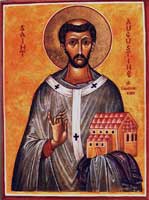
Augustine
of Canterbury.
|
Augustine
of Canterbury—the so-called "Apostle" of England—was
sent by Pope Gregory to stop the Hibernian evangelization
of England and the Continent of Europe. |
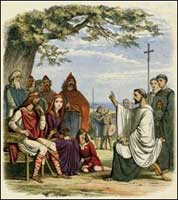
Augustine
"preaching" to King Etherlbert.
|
Here
is a quote from the History of the Scottish Nation by Dr.
Wylie:
The
result was just what might have been expected to follow the labours
of such an evangelist. The Northumbrians, forsaking Thor, whom
their fathers had worshiped, turned to Christ, and the light of
the Gospel spread over the eastern and midland counties of England
as far as the Thames. We mention the following as among the more
illustrious of these evangelists—Aidan, Finian, Colman,
Tuda, Ceadda, Caedd, Diuma, Cellagh, Fursey. Under their labours
the whole region of the Heptarchy—that is, all England from
the Thames to the Forth and Clyde, was enlightened with the knowledge
of the Saviour. But the northern missionaries
found that the worshippers of Thor were not their only opponents.
The monks from Rome, who had established their headquarters at
Canterbury, offered them a more determined though insidious opposition
than the Anglo-Saxon pagans. Of the two religions which had entered
England from the north, that of Thor and that of Iona, the monks
seemed to believe that the latter was the more heterodox. They
gained over Oswy, the King of Northumbria, to their cause, and
the first use they made of their triumph was to stop the evangelization
and drive out the preachers who had come from Iona. The second
result was the bloody battle at Nectan's Mere, which in its turn
stopped the march of the monkish host which was advancing northwards
on purpose to attack Iona, and root out the nest of heretics which
in such numbers were taking their flight southwards. Of
the Columban missionaries whom we see the monks of Augustine chasing
out of Northumbria, Bede has given us a fine picture, which we
here quote. He says: "How parsimonious, and how disinterested
and strict in their manner of life, he (Colman) and his predecessors
were, even the very place which they governed testified, by its
simplicity and plainness; for, upon their departure, very few
houses, the church excepted, were found there, and those only
such, that, without them, there could be no civil existence. They
had no money, possessing only some cattle. For whatever money
they received from the rich, they immediately gave to the poor.
Nor, indeed, had they need to collect monies, or provide houses
for the reception of the great men of the world, who, then, never
came to the church, but only to pray or hear the Word of God."
(History of the Scottish Nation,
vol. II, ch. 26, p. 336).
The Greek East
never fell into heresy like the Latin West, and Hibernia was never
part of the Papal Church, until as late as the 12th century.
Triune
immersion was practiced in Hibernia up to the 12th century
The
Orthodox still follow the Apostolic pattern and do not recognize
pouring or single immersion as valid baptism.
Up
to the 12th century, triune immersion was still the only baptismal
rite in Hibernia, although children were now substituted for adults.
At
the Council of Cashel held in Ireland in the year 1172, triune immersion
was still the correct mode of baptism:
This
synod is worthy of note as representing the voice of all the archbishops
and bishops in Ireland. It was attended also, by direction of
Henry II of England, by two of his own clergy. The design of the
synod was to procure conformity, ecclesiastical as well as secular,
between England and Ireland.
It decreed, Can. 1, "That children shall be brought to the
church, and shall there be baptized in pure water
by trine immersion, in the name of the Father, and of the
Son, and of the Holy Spirit. And let this be done by the priests,
unless in imminent danger of death it behoove that it be administered
by another person and in any other place, and then let it be performed
by any one, without distinction of sex or rank." (Chrystal,
History of the Modes of Christian Baptism, pp. 178-179).
References
Chrystal,
Rev. Charles. History
of the Modes of Christian Baptism. Lindsay and Blakiston,
Philadelphia, 1861.
Chesterton,
G.K. Saint Thomas Aquinas "The Dumb Ox." Image
Books, Doubleday & Co., New York, 1956.
Homilies
of St. John Chrysostom. John Henry Parker. Oxford and London,
1848,
Markus,
R.A. Gregory the Great and His World. Cambridge University
Press, Cambridge, England, 1997.
Quinter,
James. A
Vindication of Trine Immersion as the Apostolic Form of Christian
Baptism. The Brethren Publishing Co., Huntingdon, PA, 1886.
Roberts,
Alexander and James Donadson, eds. Apostolical Constitutions.
Ante-Nicene Christian Library . T. & T. Clark, Edinburgh, 1872.
Robinson,
Robert.
History of Baptism. Lincoln and Edmands, Boston, 1817.
Saint
Basil the Great. On the Holy Spirit. St. Vladimir's Seminary
Press. Crestwood, New York, 2001.
Thompson,
E.A. The Goths in Spain. Oxford University Press, New York,
1969.
Copyright
© 2013 by Patrick Scrivener
Back
to Deadly Errors of the Latins |











